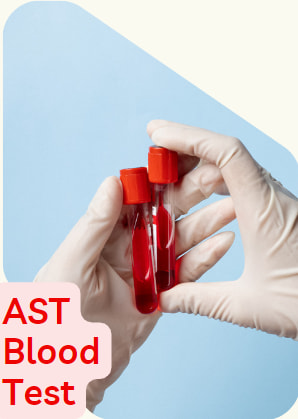Content :
◉ What is AST blood test?
AST stands for Aspartate Aminotransferase, which is an enzyme found in various tissues throughout the body, including the liver, heart, muscles, and kidneys.
The AST blood test measures the levels of this enzyme in the blood and is often used as part of liver function tests.
Elevated AST levels in the blood can indicate liver damage or injury, such as viral hepatitis, alcohol-related liver disease, drug-induced liver injury, or liver cirrhosis. However, AST levels can also be elevated due to other factors, such as muscle injury, heart diseases, or certain medications.

◉ Other names
- ASAT / AST: Aspartate-Amino Transférase
- GOT: glutamic-oxaloacetic transaminase.
- SGOT: Serum glutamic-oxaloacetic transaminase.
◉ Why it is done?
The AST blood test is done for multiple reasons:
- Assessing liver health: Elevated AST levels can indicate liver damage or injury. It is commonly used in combination with other liver function tests, like ALT, to evaluate liver function and determine the presence of liver diseases.
- Diagnosing liver conditions: The AST test can help diagnose liver conditions such as hepatitis (inflammation of the liver) caused by viruses (e.g., hepatitis B or C) or alcohol-induced liver diseases.
- Monitoring liver diseases: For individuals with known liver diseases, the AST test is used to monitor the progression of the disease and evaluate the effectiveness of treatment.
- Assessing liver function before starting medications, like statins, or surgeries.
- Evaluating other conditions: Elevated AST levels can be seen in conditions other than liver diseases, such as muscle injuries, heart diseases, or certain medications. The AST test can help identify these conditions and guide further evaluation or treatment.
◉ Preparation before the test
There are no needed any special preparations for the ALT test.
A nurse or lab tech will take a sample of your blood, usually from a vein in your arm. They will first tie a band around the upper part of your arm to make your vein fill with blood and swell up. Then they will clean an area on your arm with an antiseptic and put a needle in one of your veins. Your blood will go into a vial or tube.
Tell your doctor what drugs or supplements you take. Some medicines can affect the results of this test.
◉ Normal and abnormal levels of AST
The normal range for AST levels in the blood can vary slightly depending on the laboratory and the reference range used. In general, the normal range for AST levels is:
- For men: 10 to 40 units per liter (U/L)
- For women: 9 to 32 U/L
◉ High levels of AST
High levels of AST in the blood (more than 40 units for men and more than 32 for women), also known as AST elevation, can indicate liver damage or injury.
Some possible causes of elevated AST levels include:
- Liver diseases: Serious liver conditions such as hepatitis (inflammation of the liver), alcoholic liver disease, non-alcoholic fatty liver disease, liver cirrhosis, or liver cancer can cause increased AST levels.
- Medications: Certain medications, such as statins (cholesterol-lowering drugs), antibiotics, antifungal agents, pain relievers like acetaminophen, and certain herbal supplements, can cause liver damage and lead to elevated AST levels.
- Muscle injury: AST is also present in muscle tissue, so conditions that cause muscle damage or injury, such as strenuous exercise, rhabdomyolysis (severe muscle breakdown), or muscle trauma, can elevate AST levels.
- Heart conditions: Heart attacks or other severe heart-related conditions can cause damaged heart muscle cells to release AST into the bloodstream, resulting in elevated AST levels.
- Other factors: AST levels can also be increased due to factors like excessive alcohol consumption, strenuous physical activity, certain viral infections, or genetic conditions.
◉ Low levels of AST
Low levels of AST blood test may occur naturally in some individuals and do not necessarily indicate any specific health condition. However, it is important to interpret AST levels in the context of other liver function tests and clinical symptoms.
In some cases, low AST levels could be associated with vitamin B6 deficiency, certain liver, kidney, or inflammatory diseases.
◉ Additional tests
In addition to the AST blood test, several other tests may be needed to evaluate liver function and determine the underlying cause of liver damage or disease. These tests include:
- ALT (Alanine Aminotransferase) blood test: This test measures the levels of another liver enzyme that is highly specific to the liver. Like AST, elevated ALT levels indicate liver damage or injury.
- Alkaline Phosphatase (ALP): This test measures the levels of an enzyme present in the liver, bones, and other organs. Elevated ALP levels can indicate liver or bone diseases.
- Bilirubin: This test measures the levels of a yellow pigment produced when red blood cells are broken down. Abnormal levels of bilirubin can indicate liver dysfunction.
- Gamma-Glutamyl Transferase (GGT): GGT is an enzyme that is often used as an additional marker of liver health and function. Elevated GGT levels can indicate liver diseases or heavy alcohol consumption.
- Prothrombin Time (PT) and International Normalized Ratio (INR): These tests assess the blood's ability to clot and can indicate how well the liver is producing clotting factors.
- Serology tests: These tests check for specific antibodies or viral markers to identify viral infections of the liver, such as hepatitis B or C.
- Imaging tests: Imaging tests like ultrasound, CT scan, or MRI may be performed to visualize the liver and detect any structural abnormalities or signs of liver disease
◉ Conclusion
High AST levels in the blood can be indicators of various liver conditions, including viral hepatitis, cirrhosis, and alcohol-related illnesses.
It is essential to emphasize that aspartate aminotransferase levels are not specific, making further testing and careful clinical evaluation necessary to determine the cause.